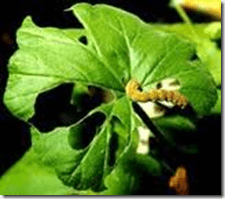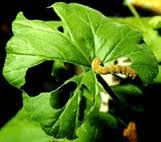-
 Geranium (Pelargonium xhortorum) is a well-loved plant for flower beds, hanging baskets and containers. Single, semi-double or double geranium flowers bloom in a wide range of colors on 12- to 20-inch tall plants. Geraniums prefer areas of full sun and moist, well-drained ground that keeps their roots cool. The plants are prone to a number of fungal and bacterial diseases and insect infestations, including worms and aphids.
Geranium (Pelargonium xhortorum) is a well-loved plant for flower beds, hanging baskets and containers. Single, semi-double or double geranium flowers bloom in a wide range of colors on 12- to 20-inch tall plants. Geraniums prefer areas of full sun and moist, well-drained ground that keeps their roots cool. The plants are prone to a number of fungal and bacterial diseases and insect infestations, including worms and aphids.
Beet Armyworm
-
Beet armyworm (Spodopter exigua) is among the worms that commonly infest geraniums. The worm or caterpillar is green to black in color, with a dark head and five pairs of prolegs. The adult moth has a 25 to 32 mm wingspan, with mottled gray or brown forewings. The worms damage the plants by feeding on young growth. The silk webbing produced by the worms creates a shiny coating on the plant. The most effective control of beet armyworm is through chemicals used by licensed applicators. In general, the chemicals recommended for use by homeowners are not highly effective in controlling the worms.
Geranium Budworm
-
Geranium or tobacco budworm (Helicoverpa virescens) is a common worm in geraniums. The worms feed on geranium petals and buds and overwinter as pupa in the soil. The worms damage is targeted on the ovaries of the developing flowers and causes unopened buds. The petals of already opened flowers have a chewed and ragged look. The damage caused by the geranium budworm is most apparent in the summer. The adult moths are light green to brown with a 1-1/2-inch wingspan. Geranium budworms are very hard to control with insecticides. Synthetic pyrethrins or pyrethroid insecticides are among the most effective control options.
Bollworm
-
Bollworm (Heliothis zea) is a type of foliage-eating worm that has a number of host plants, including geraniums. The hairy, cream-colored worms change colors through their various stages of growth, developing light colored stripes and black spots on their backs. The worms initially start to feed on tender plant terminals and gradually start damaging the flowers, buds and bolls, or the seed-containing areas. The adult moths are large, with a wingspan of 25 to 38 mm. Chemical control options for bollworm are most effective when the worms are very small, and include the use of organophosphorus insecticides.

Deprecated: strpos(): Passing null to parameter #1 ($haystack) of type string is deprecated in /home/agriviek8Qv/agriviet.net/public_html/wp-includes/comment-template.php on line 2522